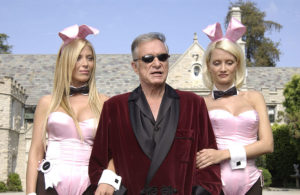Half the trick of business is knowing when to get out, and Hugh Hefner was a great businessman. “His timing was perfect,” said the New York Times obituary, when he died in September 2017. The comment referred to Hefner’s genius for anticipating the desires of a more libertarian, more consumerist post-war America: Playboy was the perfect product for the moment, selling a tasteful vision of sexual freedom — a vision that, crucially, women could buy into.
As far as Hefner was concerned, he was offering women feminism the way it should be. Being a bunny was a way to move beyond prissy morality and claim sexual empowerment. “Women were the major beneficiary of the sexual revolution,” he told Cosmopolitan in 2015. “It permitted them to be natural sexual beings, as men are. That’s where feminism should have been all along.” That was a self-serving definition from a pornographer, but it was one that some women embraced: if feminism was about a woman’s right to choose, they chose to commodify themselves for profit.
But the obituarist was more right about Hefner’s timing than she could have known. Eight days after his death, the same paper published its devastating expose of Harvey Weinstein’s serial sexual assaults against women, and the #MeToo movement quickly assembled in response. You can’t exactly call it luck when a 91-year-old dies, but if Hefner had lasted two weeks longer, the memorials would have been far harsher judgement about his influence on the 20th century.
#MeToo was, broadly, about sexual harassment; but specifically, it was about the fact that sexual harassment could happen even in industries where women’s sexuality was treated as an asset to be exploited, even in circumstances where a woman might cynically be said to have profited from the encounter. Leveraged consent was not consent. A choice made under pressure was no choice at all.
Perhaps Hefner had sensed the coming reckoning. Six months before he died, he summoned Crystal Hefner — his third and last wife, 60 years his junior — to his bedside, and made her promise to “only say good things” when he was gone. Crystal agreed, but the deathbed setting, the frail old man desperately trying to extend his powers beyond mortality? That belongs in a book — and now her promise is the title of Crystal’s memoir, in which she very much does not limit herself to saying only good things.
Life in the Playboy Mansion in the late Noughties, she writes, was controlling and transactional. A strict 6pm curfew applied to Hefner’s girlfriends; in exchange for performing regimented group sex, they got bed, board and $1,000 cash a week. To her credit, Crystal is frank about the reason she and other women entered into this high-gloss servitude. When she first visited the mansion for a Halloween party in 2008, she was 21, and Playboy promised impossible glamour and riches. “That ornate front door looked like the doorway to success, to a place that could make all of our dreams come true.”
If you became a girlfriend, you might be able to become a playmate, with a centrefold in the magazine. If you became a playmate, you might be able to parlay that into the kind of fame that Pamela Anderson or Anna Nicole Smith had achieved. Implicit was the assumption that the bad parts of these women’s stories — the stolen sex tape that humiliated Anderson, the drug addiction that killed Smith — could be skipped. In the economics of choice feminism, the undesirable costs of sexualisation were outsourced to the sexualised, never accounted for. Hefner’s mini-harem were forever kept in check by the threat — as Crystal puts it — of being replaced “by another woman with blonder hair, better breasts, and a better nose”.
Hefner had always had a type, going back to the very first issue of Playboy in 1954, which flew off the shelves on the basis of a nude Marilyn Monroe pictorial: slim, fair, busty. Anderson fit this mould, and so did Smith. But whereas in his prime Hefner had made some room for variation — he was, along with everything else, a committed anti-segregationist — by the time Crystal was in the picture, that type had calcified entirely. Photos show him flanked by eerily samey women: femaleness as an entirely fungible commodity. Their hair, breasts and noses all converge onto one ideal, which is to say Hefner’s ideal. This was a work of art as well as nature. When Crystal decided to upgrade her appearance, she went to “the plastic surgeon who did all of Hef’s girls”.
When multiple women “chose” to turn themselves into Hefner’s fantasy, the result was a brutal kind of physical competition, in which the body itself was remodelled to approach an impossible physical standard — and to demonstrate their loyalty to their master, who was not such a fan of “natural sexual beings”. Women could work within the system and even achieve short-term gains, but the toll of being an object was borne by the flesh.
The women of Playboy were rational actors, certainly, but they were acting in a tiny ecosystem governed by the whims of one man. “Nobody likes a prude, Hef would say, and I could make your own choice about whether to stay or go,” writes Crystal. “After I’d been there for a while, it didn’t feel like much of a choice.”
By this time — the late Noughties — Hefner had become a victim of his own prescience: the America of the 21st century was one he had helped to create, which meant his product no longer stood out. In a Playboy world, who needed to buy Playboy? Nudity was readily available online: why pay for softcore pictures when you could get the hardcore stuff for free? It’s symbolic of how exhausted the Playboy concept was that Hefner ended up selling his mansion to a fan from under himself before he died.
All that was left, really, was the brand. And the obvious way to make money from a brand in the 2000s was to turn it into a reality show. The Girls Next Door had been running for three years when Crystal arrived, stepping into the show as Hefner’s girlfriend number one, although not particularly successfully. As she admits in the book, she was “wooden and quiet”, although in her defence, she wasn’t being paid to be compelling. The deal was between the network and Hefner. He got $400,000 an episode, despite barely appearing. The girls — the stars — got nothing. “It didn’t even occur to me that it wasn’t a fair arrangement,” says Crystal. “I just felt lucky to be there.”
This seems like an extraordinarily unworldly thing to believe, but people — women — who felt “lucky just to be there” were foundational to large chunks of the Noughties economy. It was why girls went wild for Girls Gone Wild, even though they received no more than some cheap beads in exchange for flashing their tits. You could take your portion of the sexual revolution, only if you acceded to it happening on men’s terms.
Hefner was a pioneer here as well: he built his empire directly on profiting from women’s bodies without sharing the rewards. Anderson has said that being a playmate was “empowering”, but not so much in the financial sense. It launched her career, but in her 2023 Netflix documentary she says she didn’t get a cut from any of the calendars or videos that Playboy sold off her back. And those Marilyn nudes in the first issue? Bought from the photographer for $500. Monroe herself got nothing — a fact that was once seen as proof of Hefner’s business acumen.
And yet, if Hefner was the master of timing, his widow’s book comes too late. Crystal’s isn’t the first book not to “say good things” about Hefner. In 2015, Holly McKenzie — the number one girlfriend before Crystal — wrote her own memoir of the “betrayal and abuse” she experienced in the mansion. In 2013, Jennifer Saginor — daughter of one of Hefner’s best friends — published Playground: A Childhood Lost Inside the Playboy Mansion. Since 2022, the documentary series Secrets of Playboy has racked up an exhaustive 20 episodes. At this point in the #MeToo cycle, the victimisation of women like Crystal is well established.
In fact, she’s told the unflattering story of her time in the Playboy Mansion already — in, among other places, an interview with Howard Stern in 2011, when she and Hefner had temporarily broken up. In the book, Crystal refers to that episode regretfully, saying she “let Howard Stern coax me into saying cruel things about Hef” and “felt awful about it after… like I’d lowered myself even further into a pit of shame and regret”. Yet all she did was share the same truths she’s sharing here — describing the same rigid rules and squalid sex — in a now-unfashionable register. In 2011, she was playing the part of the shameless vixen. In 2024, she’s playing the part of the woman-child, “a kid who went trick or treating somewhere and never left”.
The truth, probably, is somewhere in between. Hefner used women, but he was only able to because women like Crystal believed they could use themselves to extract money and power from the Playboy institution. Part of the genius of choice feminism, from the male point of view, is that it makes women complicit in their own exploitation. Crystal never approaches those subtleties: she says she felt trapped, but then can’t fully articulate why, having broken her engagement to Hefner, she returned to become the last Mrs Hefner.
But it’s the subtleties that would make her interesting. I know Hefner was a goat and a shark. I would much rather read an honest account of the political acumen it takes to become the chief girlfriend, and eventually the wife, of a professionally promiscuous and very wealthy man. But in that sense, at least, Crystal chose her moment perfectly: as his widow, she’s probably the only woman to have made more money from her bargain with Hefner than he made from her.
Disclaimer
Some of the posts we share are controversial and we do not necessarily agree with them in the whole extend. Sometimes we agree with the content or part of it but we do not agree with the narration or language. Nevertheless we find them somehow interesting, valuable and/or informative or we share them, because we strongly believe in freedom of speech, free press and journalism. We strongly encourage you to have a critical approach to all the content, do your own research and analysis to build your own opinion.
We would be glad to have your feedback.
Source: UnHerd Read the original article here: https://unherd.com/




